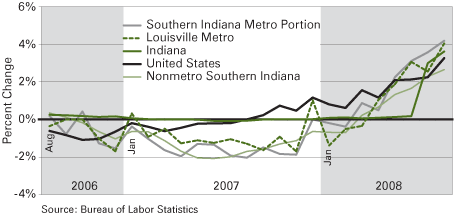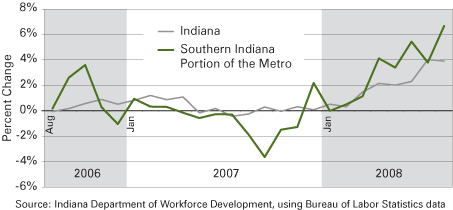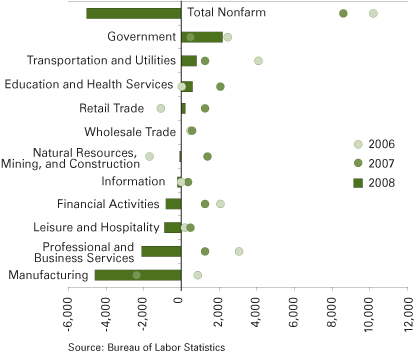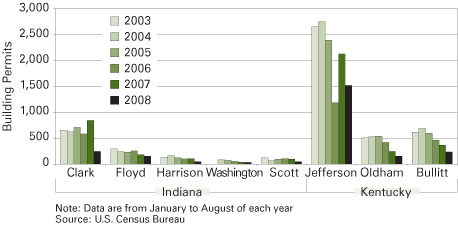Louisville Forecast 2009
Sanders Chair in Business, Indiana University Southeast, New Albany
October 2008, updated December 2008
How will Louisville weather the current financial crisis? Based on current readings of data in the Louisville metro, trends over the past year, and the historical relationship between Louisville and the U.S. economy, the outlook for Greater Louisville is an overall decrease in nonfarm payroll jobs. Unemployment could reach 8 percent, and the region will see decreases in manufacturing, construction, retail, leisure and hospitality, financial services, and professional and business services.
Labor Markets
The Louisville metro, including its four southern Indiana counties (Clark, Floyd, Harrison, and Washington), is showing significant increases in the number of people unemployed. An increasing labor force and a decrease in the number employed are interacting to produce a significant spike in the unemployment rate (see Figure 1). As of August, the Louisville metro's 6.6 percent unemployment rate was at its highest in the past 18 years.1 Southern Indiana's portion of the metro had a 6.1 percent unemployment rate—lower than the metro area, but considerably higher than the rate of 4.3 percent observed in 2007.
Figure 1: Change in Unemployment Rate from Previous Year, August 2006 to August 2008

Unemployment claims for the southern Indiana portion of the metro increased significantly compared to last year.2 The August year-over-year increase represents the largest percentage increase in unemployment claims since the recession of 2001, and the percentage change in claims exceeds the change for Indiana (see Figure 2). Does this increase represent a peak or the beginning of slower growth in the near- to intermediate-term?
Figure 2: Change in Unemployment Claims from Previous Year, August 2006 to August 2008

Nonfarm Payrolls
As of September, the Louisville metro lost approximately 5,000 jobs compared to the previous September.3 Recently released October data indicate job losses have accelerated with an overall decline of 8,200 nonfarm payroll employment. No doubt, slower national economic activity is beginning to affect the Louisville metro. The largest losses were registered in manufacturing and in professional and business services. Health and educational services showed a smaller increase than previous years, while the government sector registered strong gains (see Figure 3).
Figure 3: Change in Employment from Previous Year in the Louisville Metro, September of Each Year

Manufacturing
The Louisville metro lost approximately 4,600 manufacturing jobs from September 2007 to September 2008. The majority of these losses were in durable goods, symptomatic of consumer issues nationally. Weaker domestic consumer activity, slower global growth, declining business investment nationwide, and a resurgence of the dollar will all present challenges to local manufacturers.
Financial, Professional, and Business Services
A slower economy for 2009 is now evident for both the financial activities and professional and business services sectors. As of September 2008, financial activities lost 800 jobs. This directly relates to the ongoing struggles in the financial sector and is a sign of overall economic weakness to come. Meanwhile, the professional and business services sector recorded the first September decline (down 2,100 jobs) since the mild recession of 2001.
Consumer-Related Sectors
The developing stresses in the labor market and the recent decrease in consumer wealth resulting from financial market volatility will exert significant pressures on certain retail sectors. Retail establishments that rely on discretionary income, do not have a loyal customer base, or contain weak balance sheets will find 2009 to be a very challenging year.
While the retail sector thus far has shown some resilience, other consumer-related sectors are beginning to exhibit slower growth. The leisure and hospitality sector has shed approximately 900 jobs, the first decline since the last recession. This sector relies heavily on discretionary spending and could see some additional job losses.
Real Estate and Housing
Building permits have continued to decline. While this will present some challenges to the construction industry, we view this as an overall favorable development in the near term. A considerable decline in residential permits will allow existing homes to clear the market and help minimize downward pressures on real estate prices. As we move past problems in residential real estate, the next potential cause of concern is the commercial real estate sector. Retrenchment by consumers will apply pressure to commercial retail development.
Figure 4 shows single-family building permit activity for August year-to-date from 2003 to 2008.
Figure 4: Total Building Permits in the Louisville Metro by County, 2003 to 2008

Outlook for 2009
The Louisville metro, including southern Indiana, will see an overall loss of jobs in the coming year. A decline in national consumer spending will continue to adversely impact the manufacturing sector. Recent efficiencies gained in manufacturing will help minimize sector job losses; however, the combination of both slower global and domestic growth will present challenges to manufacturing. We will likely see further declines in financial activities and professional and business services—the result of overall economic slowness. Businesses that cater to consumer discretionary spending will see some challenges throughout the year. The loss of wealth, both in real estate and equity values, will present significant challenges to these establishments.
The unemployment rate for the Louisville metro will likely surpass 7 percent and could potentially exceed 8 percent. This will cause added pressure on the real estate sector, both commercial and residential, and on sectors that rely on consumer spending.
Notes
- Bureau of Labor Statistics local area unemployment statistics, available online at www.bls.gov/lau.
- Hoosiers by the Numbers, available online at www.hoosierdata.in.gov.
- Bureau of Labor Statistics state and metro area employment, hours, and earnings. Data are available online at www.bls.gov/sae.
Also in this Issue…
- Outlook for 2009
- International Outlook for 2009
- U.S. Outlook for 2009
- Financial Outlook for 2009
- Housing Market Outlook for 2009
- Indiana's Outlook for 2009
- Indiana's Agricultural Outlook for 2009
- Indiana's Special Sectors Outlook for 2009
- Anderson Forecast 2009
- Bloomington Forecast 2009
- Columbus Forecast 2009
- Evansville Forecast 2009
- Fort Wayne Forecast 2009
- Gary Forecast 2009
- Indianapolis-Carmel Forecast 2009
- Kokomo Forecast 2009
- Louisville Forecast 2009
- Muncie Forecast 2009
- Richmond Forecast 2009
- South Bend and Elkhart Area Forecast 2009
- Terre Haute Forecast 2009
- Return to Table of Contents



